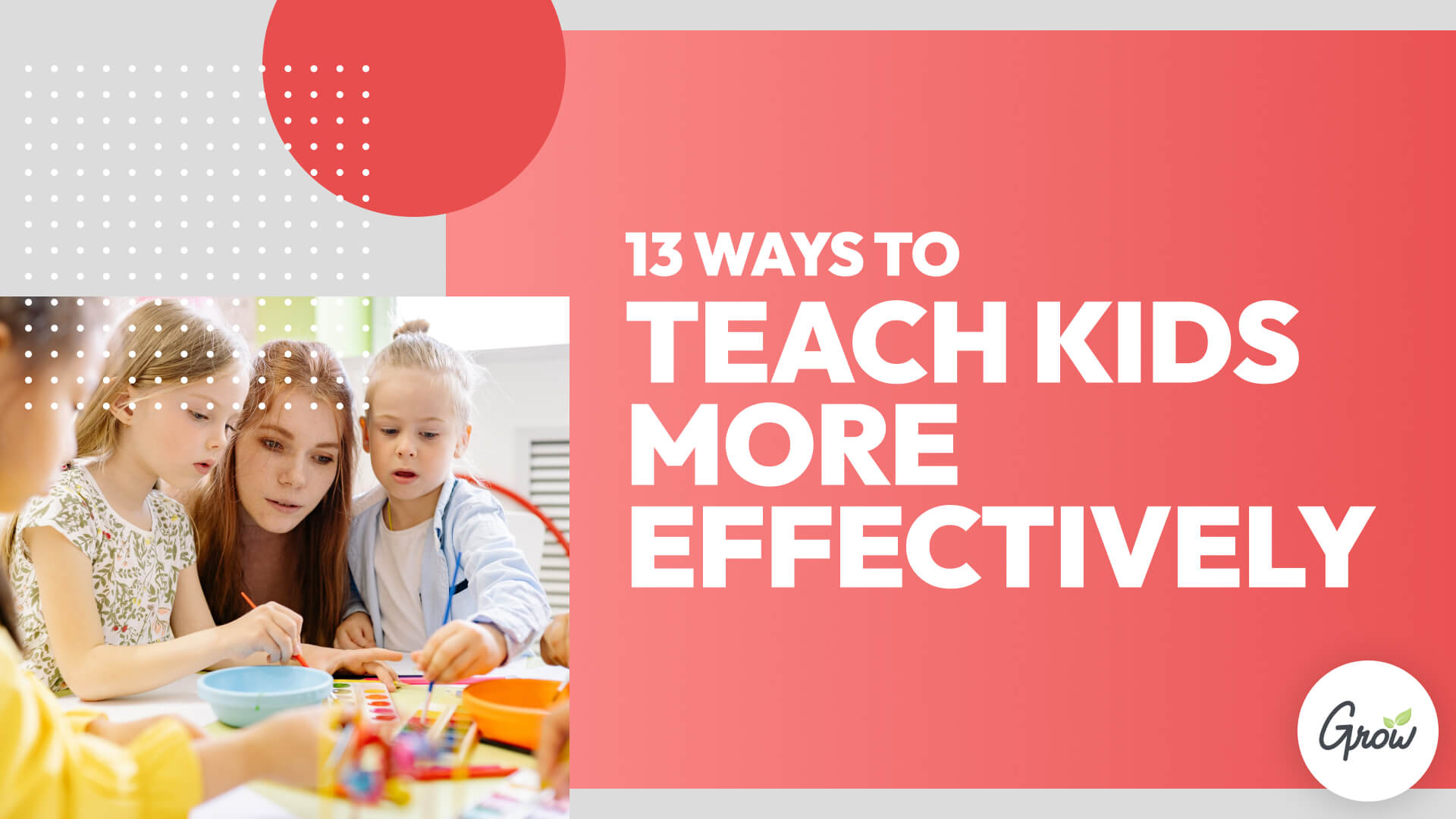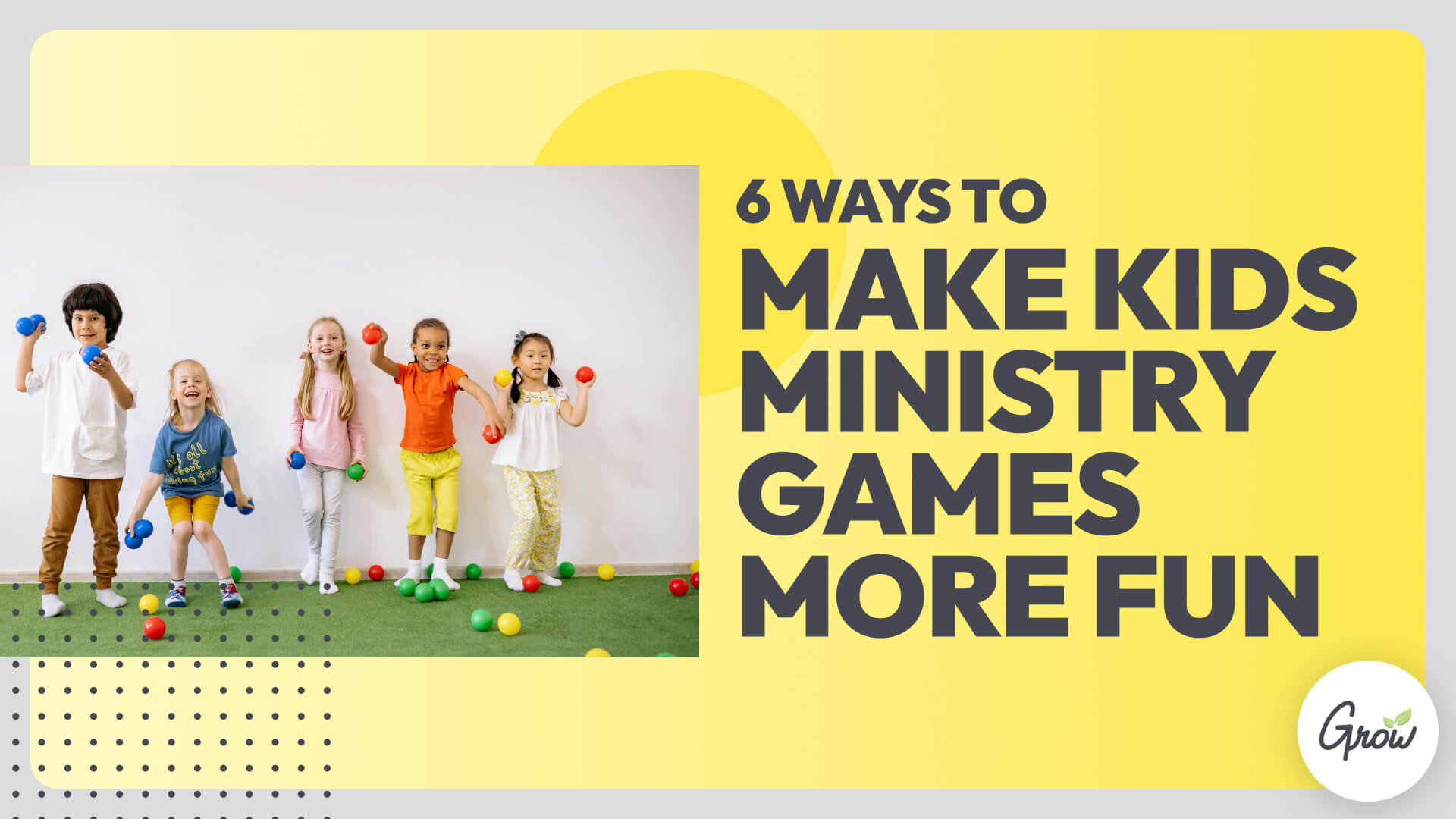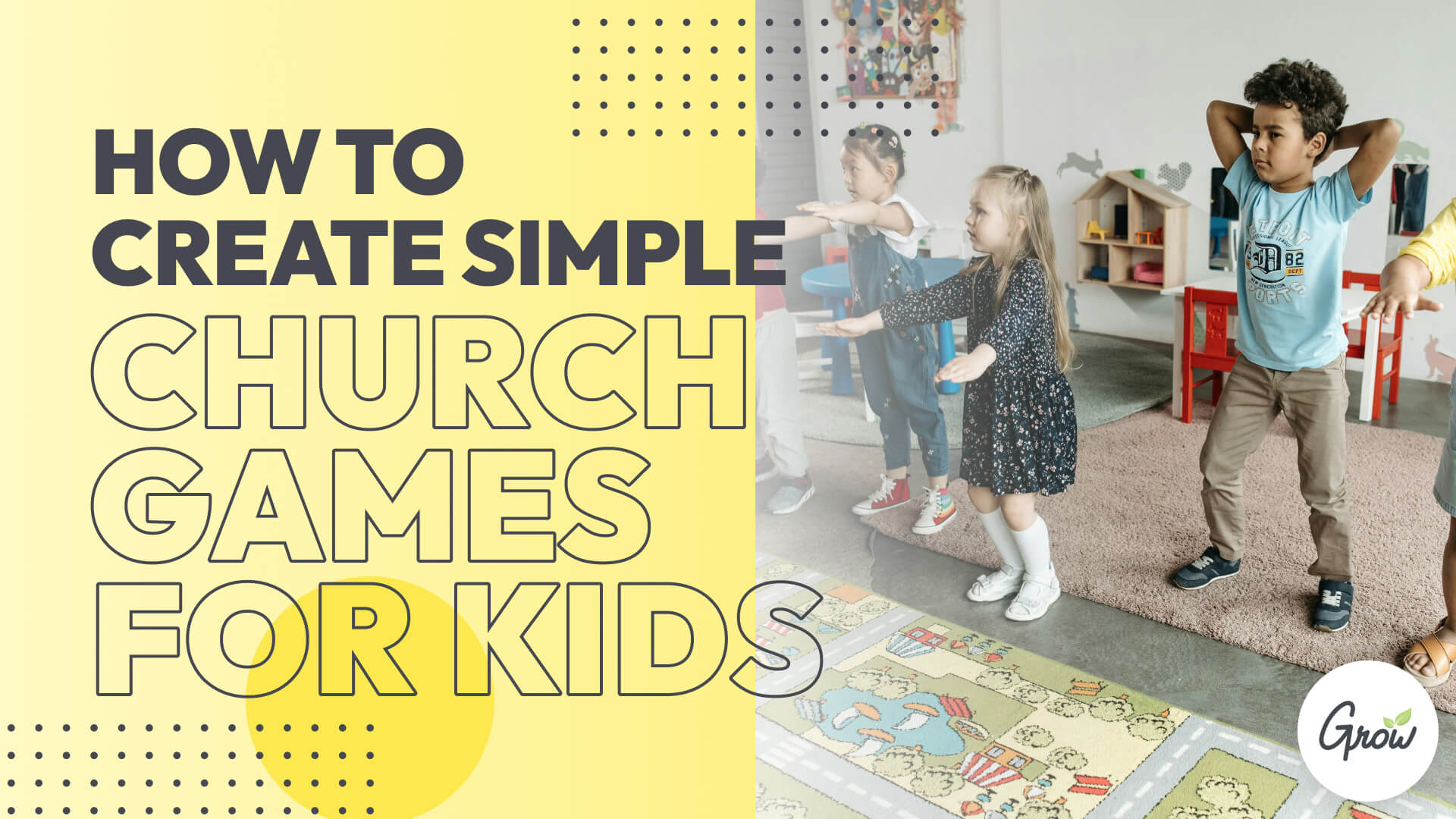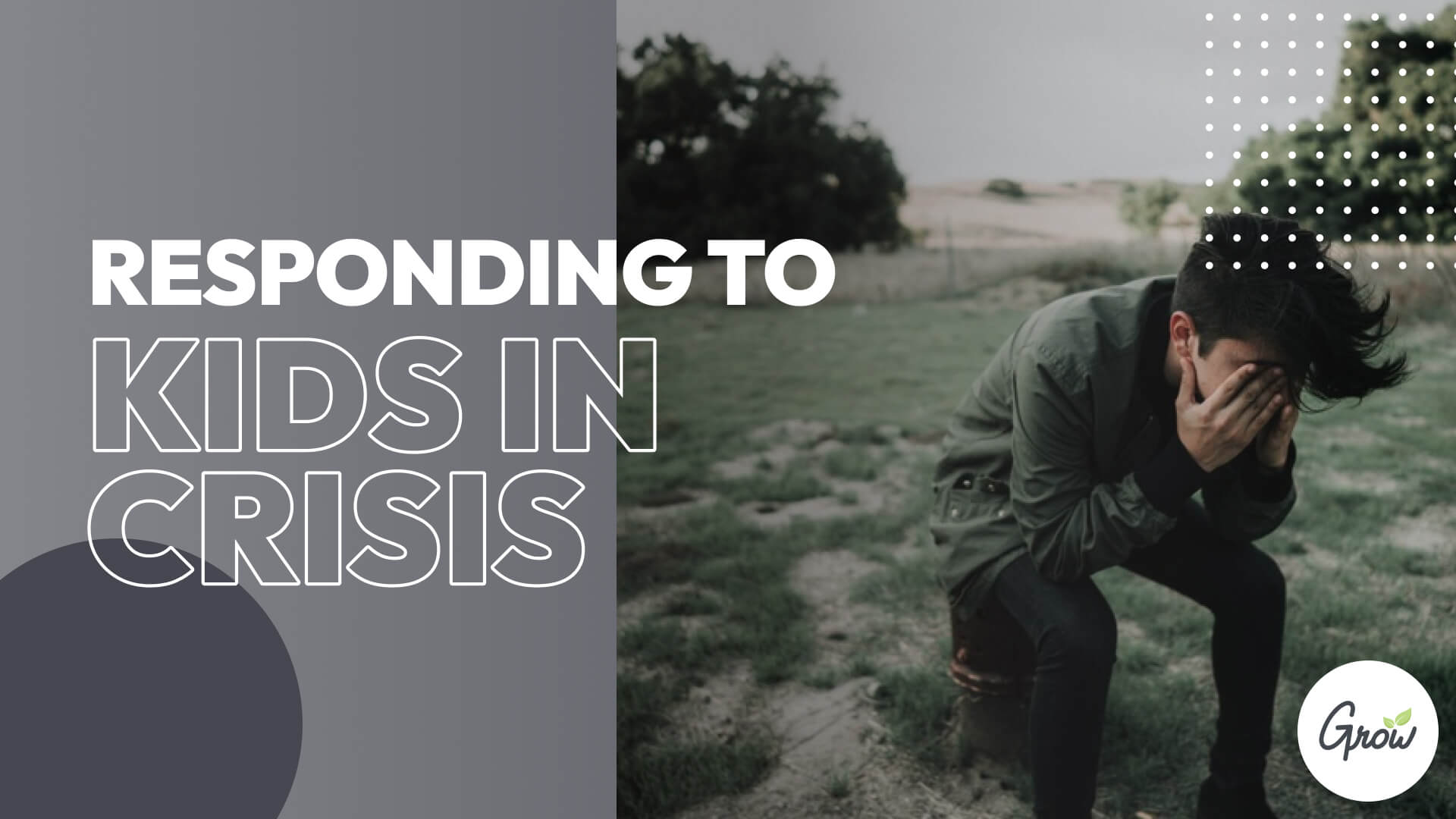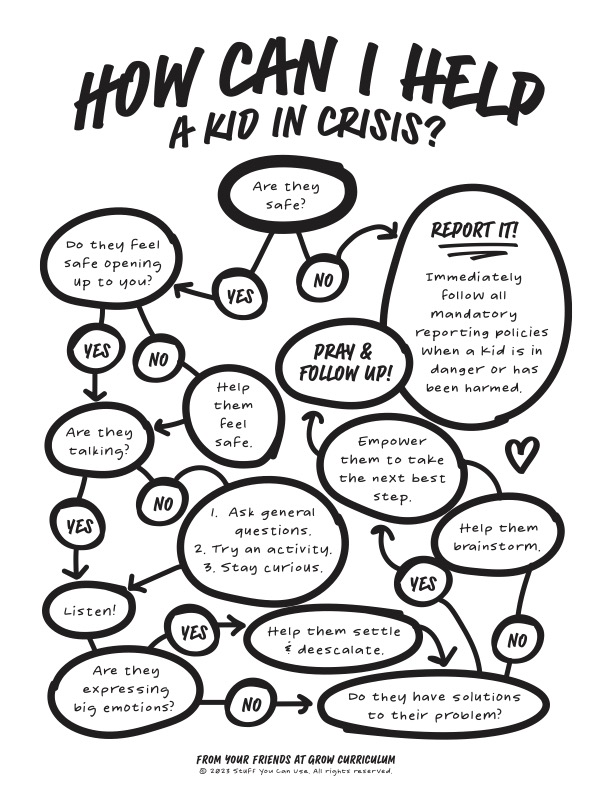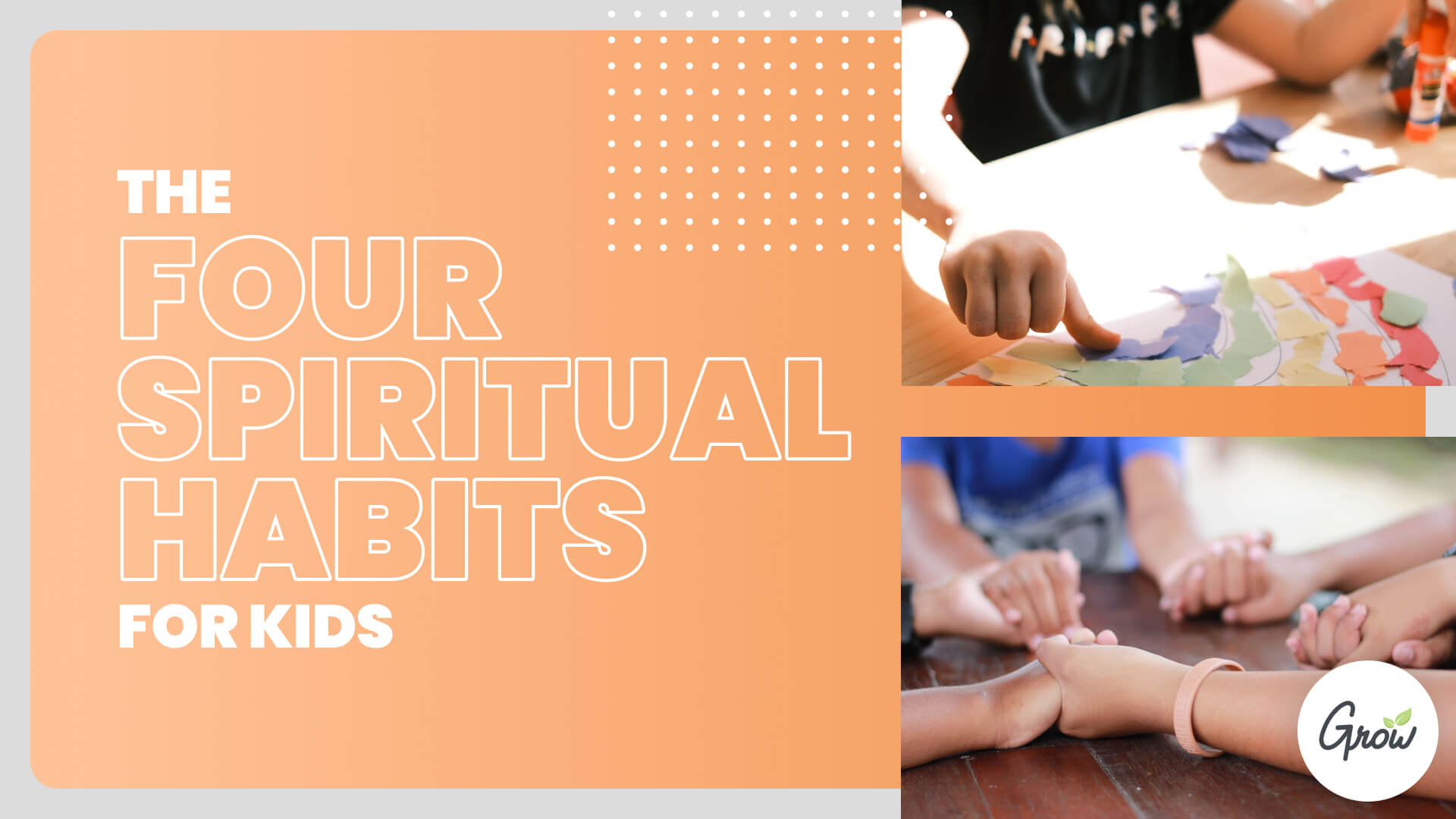
If you’re an adult (or even a “professional” Christian), then the idea of spiritual habits is probably pretty familiar to you. Spiritual disciplines, quiet time, devotions… whatever you call it, you’ve probably established a few rhythms in your life to help you grow spiritually.
Or, at least, you’re working on it.
Maybe you…
- Start your day with a quiet time.
- Follow a Bible reading plan.
- Listen to worship music while you drive.
- Subscribe to sermon podcasts.
- Go to church, attend a small group, or serve somewhere.
If you’ve been following Jesus for a while, you’ve probably figured out a few ways to grow spiritually. Since you’re a grown-up, you’ve had a little time to figure out this whole “spiritual growth” thing.
The kids in your ministry, on the other hand, aren’t grown-ups, so they might need a little help from you to figure out how, exactly, to grow spiritually.
So, what should spiritual growth look like for kids?
And how can you help them develop spiritual habits?
When I (Elle) oversaw small groups in the middle school ministry at my church, this question came up pretty often—like the time I was meeting with one of my brand new small group leaders, Peter. Peter was a college-aged guy, brand new to leading small groups, and was really, really, excited to start serving. During our first orientation meeting, while I was showing him the ropes of being a small group leader, he stopped me and asked this question:
“Okay, but… how do I help my small group grow spiritually? What’s my goal?”
It was a pretty good question. And since Jesus always answered questions by asking another question (but mostly because I needed a second to figure out what to say next) I asked Peter, “Well, what do you think your goal should be?”
“I don’t know,” he said. “Maybe my goal could be to get every guy in my small group to read the Bible seven times a week?”
Considering Peter was leading a small group of sixth graders, that was a pretty big goal. And when I say “big,” I actually mean “definitely not going to happen.” So, although I kind of loved that he was dreaming big, I said, “No, getting twenty eleven-year-olds to read the Bible seven days a week was maybe not the right goal.”
But it was a great question.
How do we help kids grow spiritually? What should our goals be?
Before we can answer that question, we should probably start by agreeing on how anyone grows spiritually.
This is where spiritual habits come in. Spiritual habits are the decisions, behaviors, and rhythms that help us grow spiritually over time. If you’re like most people, the first things that pop into your head when you hear “spiritual habits” are probably…
- Reading the Bible.
- Praying.
- Going to church.
Sure, reading, praying, and going to church are important spiritual habits. But they’re not the only spiritual habits that matter.
So what is the complete, final, definitive list of spiritual habits? Well, there isn’t one. Not officially. You can organize, categorize, and define spiritual habits in a number of ways, but feel free to steal our list if you think it’s helpful. It’s a list of the four spiritual habits we use inside Grow Curriculum to help kids, teenagers, and their leaders grow spiritually. Here they are …
1. SPEND TIME WITH GOD
This is an obvious one, right? It’s so obvious, in fact, that sometimes it’s the only spiritual habit we can name. After all, isn’t “growing spiritually” synonymous with “spending time with God”? Well, not exactly. Spending time with God is a big part of growing spiritually, but it’s not the whole picture. That’s why it’s just the first of four spiritual habits.
Spending time with God may not be the only spiritual habit, but it’s still a pretty important one. After all, if kids are ever going to make their faith their own, they’ve got to start spending time with God on their own. It means opening the Bible on their own, having conversations with God on their own, and discovering how they best connect with God through worship on their own.
HOW CAN WE HELP KIDS SPEND TIME WITH GOD?
I’m so glad you asked. Here are a few ideas …
- Give them a Bible. Preferably one with words they can understand… and written in ways they would actually say. Personally, I love the NLT, the NIV, The Message, and The Voice translations. They’re all written in language that’s easy to read, easy to understand, and easy to remember.
- Help them memorize Scripture. Your kids might be good at memorizing movie quotes, song lyrics, and whatever viral quote is happening now, but memorizing Scripture probably doesn’t come quite as naturally. That’s why it’s so helpful for us to give kids simple, practical tools for memorizing Scripture. That might look like creating songs, mixing up the words, or making it a competition.
- Teach them to pray. If you’ve been talking to God for a while, it’s easy to forget how strange prayer can seem to someone who hasn’t been talking to God for an entire lifetime. No matter their age, kids need us to model conversations with God and teach them how to have conversations of their own. So, regularly pray out loud with your group, teach them about prayer, and give them opportunities to talk to God alongside you. You might even give them simple strategies to pray, like my four favorite prayer prompts: Please, Thanks, Sorry, Wow.
- Help them discover their spiritual wiring. Gary Thomas’ book Sacred Pathways is one of the best resources I’ve found for helping people identify the unique ways they are wired to connect with God. Some of your kids will connect with God by going outside. Others will love to worship through music, or dance, or the arts. Some will love to learn, some will love to serve, and some will love to sit quietly with God in solitude. If we want to help our groups grow spiritually, it’s so important that we teach them to connect with God in the many ways they are uniquely wired to connect with God—not just in the ways we prefer to connect.
So, spending time with God is the first of four spiritual habits. This habit is all about developing a personal friendship with God. Because, just like any friendship, we can only grow closer if we’re spending time together. But if we want to grow spiritually, spending time with God isn’t the only spiritual habit we need to develop.
2. SPEND TIME WITH OTHERS
Yep, engaging in healthy community can—and should—be a spiritual habit we help our kids develop. But “healthy community” doesn’t just mean hanging out with Christians. This spiritual habit is about growing in Christlike relationships with… well, everyone. Christians and non-Christians, too. Because sometimes, it won’t be another church potluck or Bible study with our fellow Christians that will grow us the most. It might be a friendship, an investment, or a challenging conversation with a non-Christian that makes the biggest difference in our faith.
We see this most clearly in Jesus, of course. When he discipled his followers, he didn’t disciple them in one-on-one conversations in the privacy of their homes or the nearest Starbucks. He discipled them in real life, in the context of relationships that were real, and messy, and challenging, and imperfect.
In Jesus’ ministry, it was often his disciples’ interactions with each other, or with people who didn’t follow him, that prompted some of his most significant teaching opportunities.
SO HOW CAN WE HELP KIDS SPEND TIME WITH OTHERS?
Here are a few ideas…
- Create consistent small groups. If you know anything about me, you know that I’m pretty convinced small groups are the answer to just about everything. But when it comes to helping kids develop community … well, small groups are a pretty obvious first step. In small groups, kids are given opportunities to grow closer to their peers, to an adult who cares about them, and grow in community with people who believe like they do and with people who don’t.
- Offer opportunities for connection. I get it—when it comes to your weekly environment, you’ve got a lot to do and probably not enough time to do it. When you’ve got to pull off worship and small groups and announcements and your sermon, letting kids “hang out” might seem like a waste of time. But it’s not. It’s really not. If spending time with others is a spiritual habit, then creating opportunities for kids to connect with each other—and with the adults who lead them—should be a priority. So, whether it’s before your service, after your service, during the week, or at your events, prioritize relationships. Create space, through unstructured time, for kids to hang out, play, talk, and connect.
- Make your environments visitor-friendly. Sure, we all say we want visitors to show up to our programs. We all tell our groups to bring their friends to church, but if we’re not working behind the scenes to create environments that are welcoming to and mindful of, first-time guests… well, we can’t really expect those guests to show up (or come back). If you’re not sure if your environments are visitor-friendly, ask your group this question: “Is there anything about our church that makes you not want to invite your friends?”
- Encourage kids to engage in their communities. Sometimes, we make the mistake of believing our community is the only community that can help kids grow spiritually. But that’s not true, is it? We might be ministry leaders, but we don’t own the market when it comes to healthy communities. In fact, if the only community our groups see as “healthy” community are the ones our churches offer, then we’ve actually done them a pretty big disservice. If we really want our groups to grow spiritually, we should probably think of creative ways to help them build relationships (with both Christians and non-Christians) in places outside our church—like their schools, their neighborhoods, and their sports teams.
So, we’ve got to help our kids practice the habit of spending time with others, both inside the walls of our churches and outside those walls, too. Because when we engage in community, listen to different perspectives, and process our faith with others, we get a bigger picture of who God is… and that helps us grow.
3. SHARE YOUR STORY
Our kids need to learn how to talk about God. But this spiritual habit is way bigger than just knowing how to share the story of your salvation—although that’s part of it. Sharing your story is the spiritual habit of making faith a regular, everyday, go-to topic of conversation in our lives.
It’s about discovering God in every aspect of your story…
Your past, your present, and your future –
The good times, the bad times, and the in-between times –
And then sharing what you’ve found with other people.
Because when we talk about God and God’s place in our story (or, more accurately, our place in God’s story), it helps us believe, understand, and take ownership of our own faith. That’s why sharing our stories is such an important part of growing spiritually.
SO HOW CAN WE HELP KIDS SHARE THEIR STORIES?
Here are a few ideas…
- Create consistent small groups. I know, I know, I already said this. But I also said that small groups are the answer to pretty much everything. So, yes, they’re an answer to helping kids develop healthy community, but they’re also an answer for helping kids have healthy conversations about their faith. When small groups are done well, they become safe places for kids to process their beliefs, their questions, and their experiences.
- Share your stories. When you teach, be intentional about sharing stories from your own life and faith journey. In fact, you probably want to tell one personal story in every message you ever teach. When you share your stories and how God used those stories to help you grow spiritually, you give your group a model for what it looks like to find God in their stories. And when you share your stories of failure, disappointment, or mistakes, you let them know that God can work even in the toughest situations—and that they’re not alone.
- Invite kids and volunteers to share their stories. Your stories, dear ministry leader, are really important, but they’re not the only stories that matter. When you invite kids, and volunteers to share their stories regularly (maybe on stage, in a video, or on social media), you help your group connect with even more people and even more stories.
- Create space for hard questions. If you want kids to get comfortable having conversations about their faith, it is absolutely essential that you help them have healthy conversations about their doubts, fears, and questions. The truth is, your kids have (or will have) doubts. So, if you want them to have a healthy faith, help them learn to talk about those things openly.
Help your kids share their stories because they’ll grow spiritually when they make it a habit of talking about their faith.
4. USE YOUR GIFTS
Here’s the fourth and final spiritual habit: your group needs to know that God made them unique and special with really specific gifts, talents, passions, and resources. Then, they need to use those gifts to love God, love others, and influence the world around them.
When we use our gifts, we acknowledge that the things we’ve been given weren’t given to us by chance. They were part of God’s design. Using those gifts really can be a spiritual habit because when kids begin to discover who God made them to be, they grow. And when they use their unique identity to make a difference in the world, they serve others and give back to God who made them.
SO HOW CAN WE HELP KIDS USE THEIR GIFTS?
Here are a few ideas…
- Create opportunities to serve. It’s one thing to tell kids to serve others and to use their gifts. But it’s another thing entirely to actually create opportunities where they do that. Maybe you need to restructure some things in your church so that it’s easier for your groups to serve. Maybe you need to move away from an adult-led worship band so more kids and students can help lead. Maybe you even need to let go of some of your desire for “excellence” in your programming so your group can take ownership and help create your weekly environments. This might look like having them lead a craft, a game, or your memory verse hand motions.
- Showcase their unique talents. In ministry, we often accidentally communicate that the only way to serve God in ministry is from a platform. Speaking and leading worship are great ways to help kids serve, but they’re not the only gifts they can use to serve God and others. Whether it’s art, or science, or baking, or sports, your groups are overflowing with talents. They may just need your help to discover how those talents can be used to love others in new and creative ways.
So those are the four spiritual habits that help kids grow spiritually.
- Help them spend time with God.
- Help them spend time with others.
- Help them share their stories.
- And help them use their gifts.
But before we wrap up, a few things to remember…
- Your kids won’t all grow in the same way. God made them unique, after all.
- They won’t grow at the same pace. They’re all on a unique journey.
- But they can all grow just a little bit more. You can’t force spiritual growth, but you can help them take one more step toward a faith that’s growing.
And hey, thank you for the investment you’re making in the spiritual growth of the kids in your ministry. I know it’s not always easy. Actually, it’s really hard sometimes. But as you get ready for another day, or another week, or another year of youth ministry, we really hope you remember this: what you are doing is making a difference.
I know that’s hard to remember when the seeds you’ve been planting seem to be taking so long to grow, and you know there’s a pretty good chance you may never even see the end result. But keep going.
-Elle Campbell






